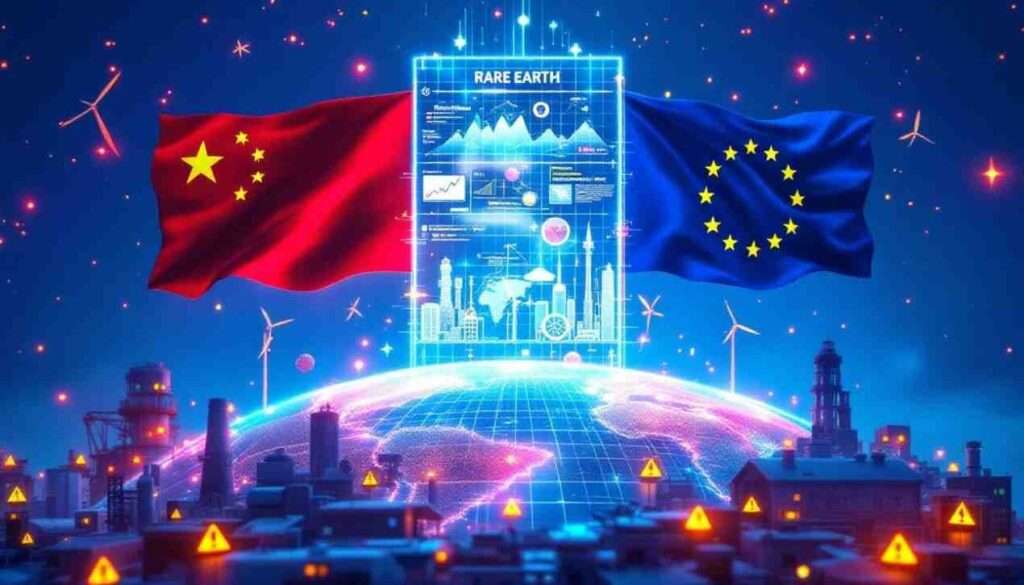For decades, Europe has relied on China for the building blocks of the modern world. The lifeblood of the green and digital economy, rare earth elements -17 minerals that are the building block of everything from electric vehicles and wind turbines to smartphones and military apparatus have been so critical. But today, as geopolitical tensions erupt and supply chains become tenuous, Europe is finally signalling its profound commitment to rare earth independence.
The wakeup call of Europe:
Europe’s dependence on China for rare earths was made explicit by a chain of critical events. First to disrupt global shipping was the COVID-19 pandemic in 2020. Supply actions could be weaponized, as demonstrated by China in 2010 when it stopped exports to Japan and in 2020-21 when it threatened the U.S. and EU. The Russia-Ukraine war further played up the danger of depending on a single supplier for critical materials. The European Union was, in fact, prompted into action by these events, leading to the adoption of its Critical Raw Materials Act (CRMA) in March 2023. The CRMA, with eyes set on 2030, requires at least 10% of rare earths to be mined inside the EU, 40% to be processed locally, 15% of demand to be supplied through recycling, and limits any non-EU country from supplying more than 65% of any critical raw material.
The New Frontiers in Europe: Mining and Processing
With major projects dotted along the continent, Europe is increasing its own production of rare earth elements. In 2023, Sweden’s LKAB made the announcement of over one million tonnes of rare earth oxides in the Kiruna deposit. Production could start by 2028. Public and private exploration funding has backed the estimated 500,000 tonnes of reserves in Norway’s Fen Complex. Environmental issues have suspended the development of Greenland’s Kvanefjeld Project, which is estimated to possess 11% of the rare earth reserves in the world. Meanwhile, about 2,500 tonnes of rare earth elements are refined every year at Estonia’s Silmet Plant, the sole large,rare earth separation plant in the EU. By 2030, the EU investments in separation and refinery technologies are expected to reach €3.5 billion, with the help of both government support and
Strategic Global Partnerships
To diversify away from its massive dependence on China, the EU is building strategic alliances with resource-flush nations. Deals involve MoU’s with Australia, the third-largest producer of rare earths in the world; Canada, which is targeting 12,000 tonnes of REEs production by 2026; and African suppliers such as Namibia and Democratic Republic of Congo for rare earths and cobalt. The EU has also partnered with the United States via the Minerals Security Partnership (MSP) to establish secure, transparent, and sustainable supply chains. In combination, such partnerships are meant to diversify sourcing, increase geopolitical resilience, and assure ethical mining in the entire supply chain.
Challenges to Europe:
Though with high momentum, the path to rare earth self-sufficiency is a long one: environmental resistance puts back projects but mainly so in Portugal and Greenland, where residents and green groups have blocked mining licenses on environmental grounds. Europe also does not have large-scale magnet production plants critical for EV motors, wind turbines, and military applications creating downstream bottlenecks. Today, more than 98% of the EU’s permanent magnets are imported, mostly from China. It would take 7-10 years to build a complete rare earth value chain from mining to refining, processing, and end product, and this would involve not only capital but also competent labor, new refining technology, and regulatory harmonization among member states. Nevertheless, the EU is committed. With the funds and funding committed in total to projects of rare earth elements by all the national governments and Project of Innovation till the middle of the year 2025, more than one billion two hundred million euros have been allotted In addition, R&D attracted some 800 million euros for recycling and alternative magnet materials.
Changing the status of independence for rare earth materials marks a major situational alteration for Europe. In this regard, by developing its home sources and cooperating with other countries, the EU aims for a sufficiently robust supply system to race with others. Still, they must keep in mind that the environment should be taken into consideration due to very strong growth demands in their endeavours. In like manner, this would involve closing technology gaps such as magnet-making and turning plans into actualities. The success of Europe shall not only translate to regional independence but will also place the manufacture of clean and sustainable rare earths on the world map.

